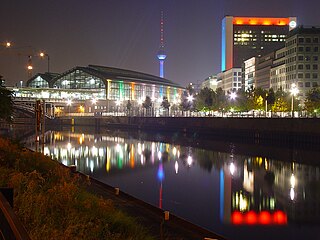
The Berlin S-Bahn is a rapid transit railway system in and around Berlin, the capital city of Germany. It has been in operation under this name since December 1930, having been previously called the special tariff area Berliner Stadt-, Ring- und Vorortbahnen. It complements the Berlin U-Bahn and is the link to many outer-Berlin areas, such as Berlin Brandenburg Airport. As such, the Berlin S-Bahn blends elements of a commuter rail service and a rapid transit system.

A low-floor tram is a tram that has no stairsteps between one or more entrances and part or all of the passenger cabin. The low-floor design improves the accessibility of the tram for the public, and also may provide larger windows and more airspace.
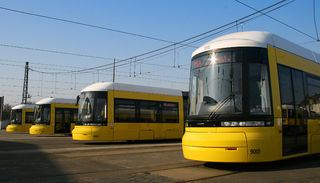
The Berlin tramway is the main tram system in Berlin, Germany. It is one of the oldest tram networks in the world having its origins in 1865 and is operated by Berliner Verkehrsbetriebe (BVG), which was founded in 1929. It is notable for being the third-largest tram system in the world, after Melbourne and St. Petersburg. Berlin's tram system is made up of 22 lines that operate across a standard gauge network, with almost 800 stops and measuring almost 190 kilometres (120 mi) in route length and 430 kilometres (270 mi) in line length. Nine of the lines, called Metrotram, operate 24 hours a day and are identified with the letter "M" before their number; the other thirteen lines are regular city tram lines and are identified by just a line number.
Bombardier Transportation was a Canadian-German rolling stock and rail transport manufacturer headquartered in Berlin, Germany.
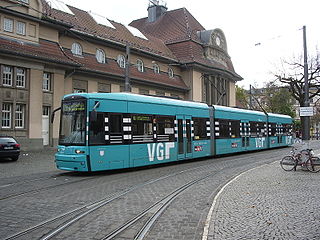
The Bombardier Flexity Classic is a model of light-rail tram manufactured by Bombardier Transportation. Although it is marketed as the most traditionally designed member of the Flexity family, it is still a modern bi-directional articulated tram with a low-floor section allowing good accessibility, especially to passengers in wheelchairs. Flexity Classic trams run on 1,435 mmstandard gauge in Australia, 1,000 mmmetre gauge in Essen, 1,450 mm in Dresden, and 1,458 mm in Leipzig.

The Socimi Eurotram was an electric tramcar designed for the tram system of Compagnie de Transports Strasbourgeois (CTS). Initially produced by Socimi, after the company became bankrupt Eurotrams were manufactured first by ABB Group's transportation division, then by Adtranz and finally by Bombardier Transportation, who marketed the tram as part of their Flexity Outlook range.

The Berliner Verkehrsbetriebe is the main public transport company of Berlin, the capital city of Germany. It manages the city's U-Bahn underground railway, tram, bus, replacement services and ferry networks, but not the S-Bahn urban rail system.

The ADtranz low floor tram was introduced in the 1990s as the world's first tram with a completely low floor design. This tram was developed by MAN for the Bremen urban transport system. The prototype, tram number 3801, was first publicly introduced on 9 February 1990. From 1991 to 1993, it was being tested in many European cities. Ten German cities have purchased this type. Adtranz took over the rail division of MAN in 1990.
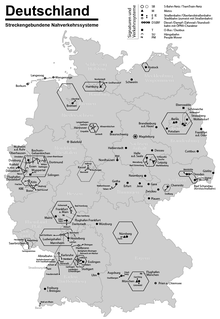
Germany has an extensive number of tramway networks. Some of these networks have been upgraded to light rail standards, called Stadtbahn in German. Straßenbahn and Stadtbahn schemes are usually operated on the legal foundation of the BOStrab, the Tramways Act of Germany.
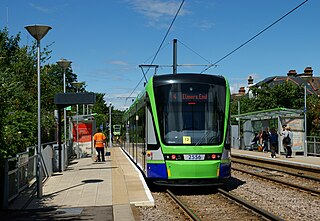
The Stadler Variobahn is a German-designed model of articulated low-floor tram and light rail vehicle. Since its introduction in 1993, the Variobahn has been manufactured variously by ABB, Adtranz, Bombardier Transportation, and since 2001 by Stadler Rail. As of 2009, 254 trams have been ordered, with an additional 110 on option. A unit costs about €2.5 million.

The Norrköping tramway network is a system of trams forming a principal part of the public transport services in Norrköping, Sweden. It has been in service since 1904, and is, along with the larger Gothenburg tram network, one of only two city-centre tramways in Sweden that survived the switch to right-hand traffic in 1967, which led to the replacement of most Swedish tramways with buses to reduce the cost of replacing their now-unusable fleets.

Berlin has developed a highly complex transportation infrastructure providing very diverse modes of urban mobility. 979 bridges cross 197 kilometers of innercity waterways, 5,334 kilometres (3,314 mi) of roads run through Berlin, of which 73 kilometres (45 mi) are motorways. Long-distance rail lines connect Berlin with all of the major cities of Germany and with many cities in neighboring European countries. Regional rail lines provide access to the surrounding regions of Brandenburg and to the Baltic Sea.

The Strausberg Railway is a light railway serving the town of Strausberg in Brandenburg, Germany. It links central Strausberg with the Strausberg railway station, where it connects with trains on the Berlin S-Bahn and the Niederbarnimer Eisenbahn. Although formally constituted and regulated as a railway, the line uses tramway style rolling stock and is superficially indistinguishable from a tramway.

The Dresden tramway network is a network of tramways forming the backbone of the public transport system in Dresden, a city in the federal state of Saxony, Germany. Opened in 1872, it has been operated since 1993 by Dresdner Verkehrsbetriebe (DVB), and is integrated in the Verkehrsverbund Oberelbe (VVO).

The Leipzig tramway network is a network of tramways which together with the S-Bahn Mitteldeutschland forms the backbone of the public transport system in Leipzig, a city in the federal state of Saxony, Germany. Opened in 1872, the network has been operated since 1938 by Leipziger Verkehrsbetriebe (LVB), and is integrated in the Mitteldeutscher Verkehrsverbund (MDV).

The Bombardier Flexity 2 is a family of tram or light-rail vehicle manufactured by Bombardier Transportation. It is 100% low-floor, in order to easily accommodate wheelchairs and pushchairs. The trams are bi-directional, with cabs at both ends and doors on both sides, and are articulated with five sections. This family of trams debuted on the Blackpool Tramway, England.

Ferry transport forms part of the transport network of Berlin due to the city's extensive network of rivers, lakes, and canals.

In 2012, Blackpool Council ordered 16 Bombardier Flexity 2 trams for the Blackpool Tramway, becoming the worldwide launch customer for Bombardier Transportation's new design. The modern 100% low-floor trams replaced the Blackpool Tramway's tourist-focused and high maintenance heritage fleet, some of which have been retained with modifications for use as a supplementary fleet alongside the Flexity 2 trams and some for tourist services on the promenade. Blackpool's Flexity 2 trams are intended to be suitable for daily commuters and to provide a service competitive with other modes of transport and comply with legislation on accessibility for disabled users.

The Potsdam tramway network is a network of tramways forming part of the public transport system in Potsdam, the capital city of the federal state of Brandenburg, Germany.

Bombardier Flexity is a family of modern trams, streetcars and light rail vehicles manufactured by Bombardier Transportation, since 2021 a division of French company Alstom. As of 2015, more than 3,500 Flexity vehicles are in operation around the world in Europe, Asia, Oceania, and North America in 100 cities among 20 countries internationally. Production of the vehicles is done at Bombardier's global production plants and by local manufacturers worldwide through technology transfer agreements.



















